The OnePlus 3 Review
by Brandon Chester on June 20, 2016 8:00 AM EST- Posted in
- Smartphones
- OnePlus
- OnePlus 3
GPU Performance
GPU performance is one of the areas where Snapdragon 810 actually tended to do quite well. It's also the case that GPUs generally see larger performance gains year over year than CPUs. We already saw how Adreno 530 performs in the LG G5 review, but the device being compared to was the LG G4, which used Snapdragon 808. The OnePlus 3 represents an opportunity to compare a Snapdragon 810 device to its successor using Snapdragon 820.
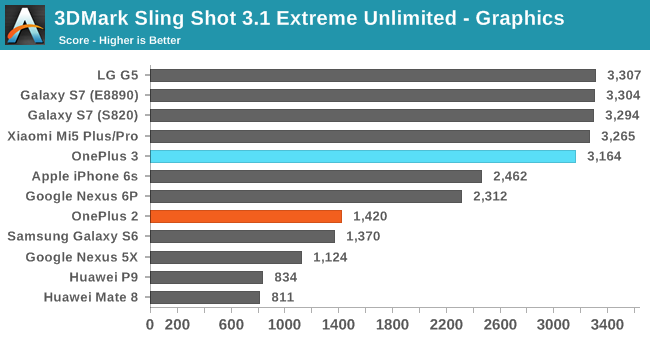
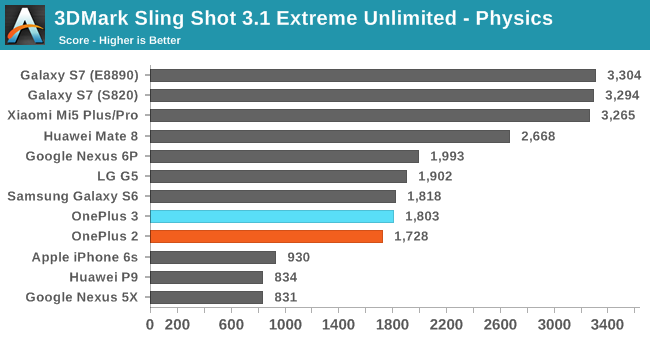
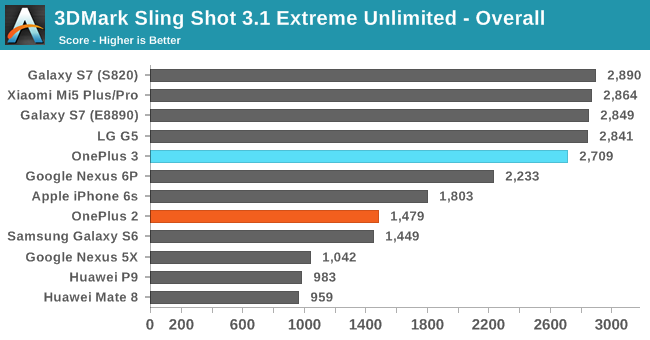
The OnePlus 3 does very well in 3DMark Sling Shot. In both the physics and graphics tests it trails the LG G5 slightly, but the gap isn't anything truly significant. Exynos 8890 is still not something I can compare to until our Galaxy S7 review is posted, but barring that it's clear that Snapdragon 820's Adreno 530 gives the fastest smartphone performance in this test, and when looking at the graphics performance the performance is over two times faster than the OnePlus 2.
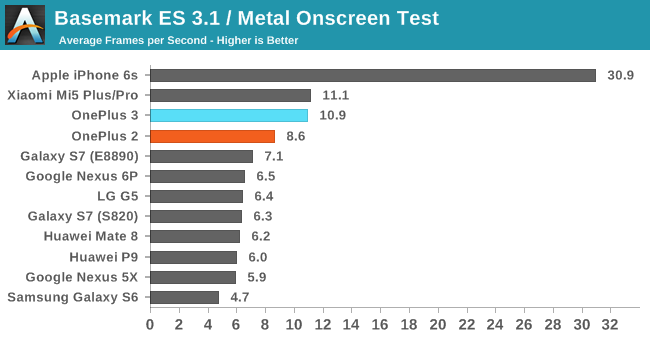
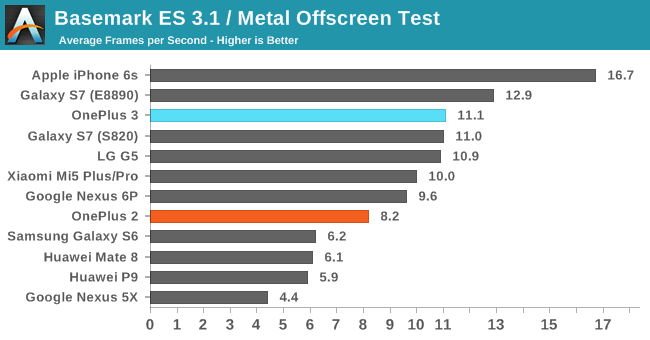
In BaseMark ES 3.1's on screen test the OnePlus 3 manages a significant lead over the LG G5 as a result of its lower resolution. In the off screen 1080p test both phones have essentially the same performance, which is what you'd expect. It looks like Adreno 530 doesn't make the same gains in this test that it does in some others, and it's not clear whether this is just the result of driver optimizations or something about the benchmark that is able to perform batter on other GPU architectures, which could be contributing to the iPhone's lead even in the off screen test.

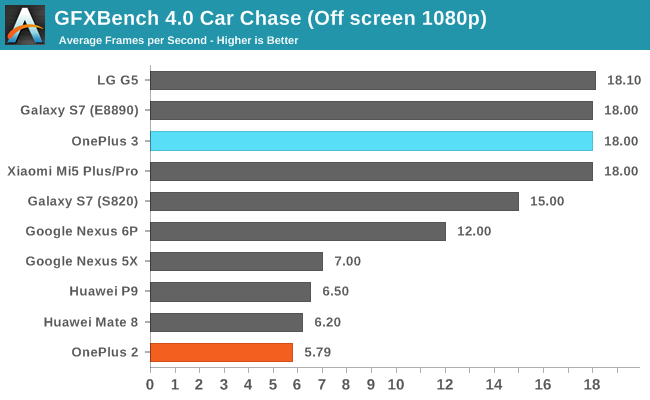
In GFXBench Car Chase the performance of the OnePlus 3 is in line with the LG G5. On screen performance is significantly higher due to the lower resolution display, while off screen performance at 1080p is about the same as the G5 and exactly the same as the on screen result. As far as absolute GPU performance goes, both of our Snapdragon 820 devices are at the top of the chart for absolute performance, and that's good news for anyone playing games or using software that benefits from a powerful mobile GPU.
NAND Performance
The OnePlus 3 moves to a UFS 2.0 NAND solution, which OnePlus claims is three times faster than the eMMC storage used in the OnePlus 2. In more realistic testing you probably won't end up achieving speeds three times faster than the OnePlus 2 since it actually wasn't slow at all by eMMC standards, but there should be a decent uplift in NAND performance nonetheless.
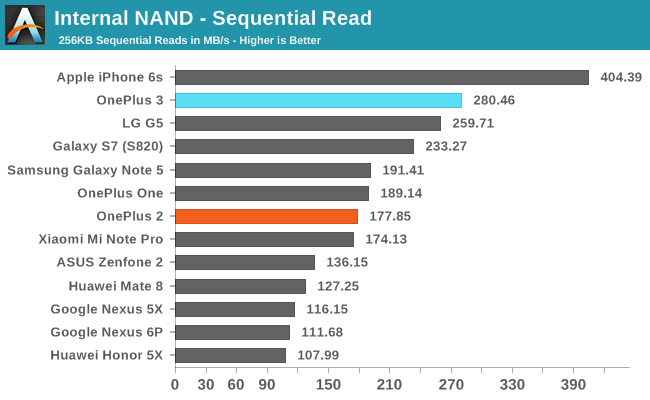
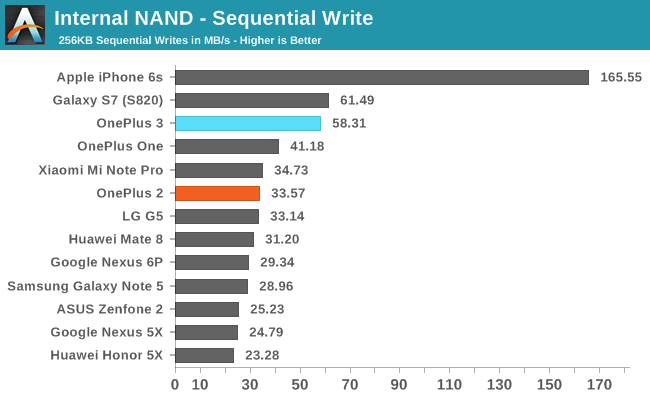
The move to UFS 2.0 brings healthy gains over the OnePlus 2's storage performance, although as I said, the OnePlus 2 didn't perform poorly at all by the standards of eMMC devices. Sequential read and write performance is actually the best that I've measured so far on an Android device. We're still not looking at anything close to what you get for sequential performance on iOS devices, but there are some other factors at play like the fact that the iPhone was a 128GB unit while our Android devices are usually 32GB or 64GB devices. In any case, the OnePlus 3 doesn't present any problems with storage performance, and you certainly won't run into the same issues that you can with budget smartphones at the $200-300 range where the eMMC solutions can be exceptionally slow.










176 Comments
View All Comments
Ian Cutress - Monday, June 20, 2016 - link
We did some in the past, when Audio Precision let us borrow the $50k+ kit needed to do some proper testing. However, AP wanted the hardware back and Chris is no longer at AnandTech. If someone can convince AP to long-term loan us the hardware, I'm sure one of our smartphone team would pick up the mantle for the devices they test (and because the team is four people, it would only be tested on 1/4 of devices unless we get duplicates or can hand some off when people travel internationally for events. It also means you'd be lucky to see release day data, and we might have to do audio focused testing. But that all depends if we can get the hardware.)http://www.anandtech.com/show/8078/smartphone-audi...
dishayu - Monday, June 20, 2016 - link
Thanks for the response. Yeah, sounds like a challenge and a half. I am aware of the past audio testing, which is why I was hoping for more. Maybe a more practical approach would be to send one person to a partnered lab and run a gauntlet test on all phones released in that year... like a shootout, maybe.cheinonen - Tuesday, June 21, 2016 - link
Yeah, I'm no longer here but the equipment made to do that level of audio testing is incredibly expensive. I live down the street from Audio Precision so I could borrow it, but most people testing audio quality are using gear with noise levels that are high enough that you can't trust the testing unfortunately.Spectrophobic - Monday, June 20, 2016 - link
That... is one disgusting screen.Google please refresh the 5X with an 820 and UFS 2.0.
tipoo - Monday, June 20, 2016 - link
So provide 6GB RAM, then make the software aggressively cull its use to save energy?Apart from future proofing (and to be real, it'll probably run out of Android updates well before 3/4GB would be a limit), that seems rather pointless.
I'd hope like the author hopes that an over the air update would address that, but if the founder said it was to save energy, maybe it's just an intentional choice they'll keep around until 6GB makes any sort of sense in a phone (which again, is probably outside of the usable life of this one).
That said, I think they're generally back on track which is nice. The Oneplus One was a hit, the Two was a miss, this seems closer to the One competitively.
tipoo - Monday, June 20, 2016 - link
So 10 months after launch, much closer to the launch of the 7 now than the 6S, the NVMe storage solution is still pooping all over everyone elses, huh? The OP3 is the closest to bridging the gap on reads, but still a whole 128MB/s behind, and much further in writes (which are cool particularly for app installs - I barely see the install icon anymore after the download).I'm curious, is it *because* of NVMe? It doesn't seem like it should be, I mean NVMe is awesome but mainly reduces the AHCI latencies and gives a stupid amount of in flight queues that consumers probably don't approach often. Is it just how many channels Apple gives their NAND? Is there a limit to how much UFS 2.0 can scale up?
All this said, on the flip side, NVMe seems to take a hit in 4KB random reads/writes, with Samsungs controller overtaking the 6S there, among some others.
tipoo - Monday, June 20, 2016 - link
Hm, I see the author also suggests it's because the 6S was the 128GB model. I guess I had assumed they'd all perform the same, despite always knowing larger SSDs usually do better due to more channels.Now I want to test a 16GB 6S to see how the storage fares. What test is used?
Pissedoffyouth - Monday, June 20, 2016 - link
Random read and write matters much more than sequential, expect for heavy burst photography which the 6GB RAM should help withtipoo - Monday, June 20, 2016 - link
I recall some of the early generations of SSDs had 4K random read/write performance as a culprit for why they would freeze up for a second in worst case situations on a PC, and increasing the random performance was found to be an important metric back then as much as if not more than sequential transfers.However I do wonder at what point of 4K random read/write performance increases is where it will no longer provide any extra kick to most consumer workloads, while hopefully the OS is writing app binaries in nice sequential rows for app launch reads. Going down to 4KB reads would still very much be a very worst case scenario.
thek - Monday, June 20, 2016 - link
I feel like the reviewer reviewed this device as on-par with other premium/flagship devices that literally cost twice as much and not take into account the device's cost. And I'm not talking about just mentioning the cost itself here.The question should be if devices that cost less(and we're really talking about 1/2 the price of any flagship, with literally the same hardware) should be reviewed differently. Now, by differently I don't mean with different or lower standards ,but maybe with the knowledge that this device is clearly cheaper than other flagships devices for a reason. Something had to be cut back.
If the display was premium as well, that device wouldn't been able to get to a 399$ price mark and make a profit (only makes sense). So if it's not reaaally crucial I'd say it's a slight issue but not one to make you not purchase the phone.
Basically I'm just saying all of this because the last 3 paragraphs really dished the device into making it seem like a no-buy right now to anyone that doesn't want to suffer from a really bad display (again, this is how it sounds to a non-technical guy that just wants a smartphone). Furthermore, as you mentioned, you are a pro reviewer and have different standards, that maybe do not imply to regular users? Yes, you've mentioned it(very slightly), but saying something like you won't replace your old low end phone for this one just because of the display makes it sound probably worse than it is(or actually, the worse it can be: ''but for anyone who cares even the slightest bit the issues with the OnePlus 3’s display will be too severe to live with.''). I'd recommend providing the device for some day to day users/family members and asking if they enjoy the display.
With all of that said, I think that companies that are trying to do things differently for the better or to be cheap on the consumers expense (like Samsung, Apple, and basically any other that charges double the amount for the same hardware or charges premium prices every year for the same old battery's and storage- which Xiaomi showed us with the Redmi note 3 pro that a 4000 battery is possible with a 200$ or less phone) should be praised.
Only god knows why reviewers provide each year an A grade score for the Galaxy's and Iphone's when they don't even provide bigger batteries which is clearly out of making us buy their next phones again next year.
I'd bash them, and not OP or Xiaomi for trying to provide more for less. just my 2 cents